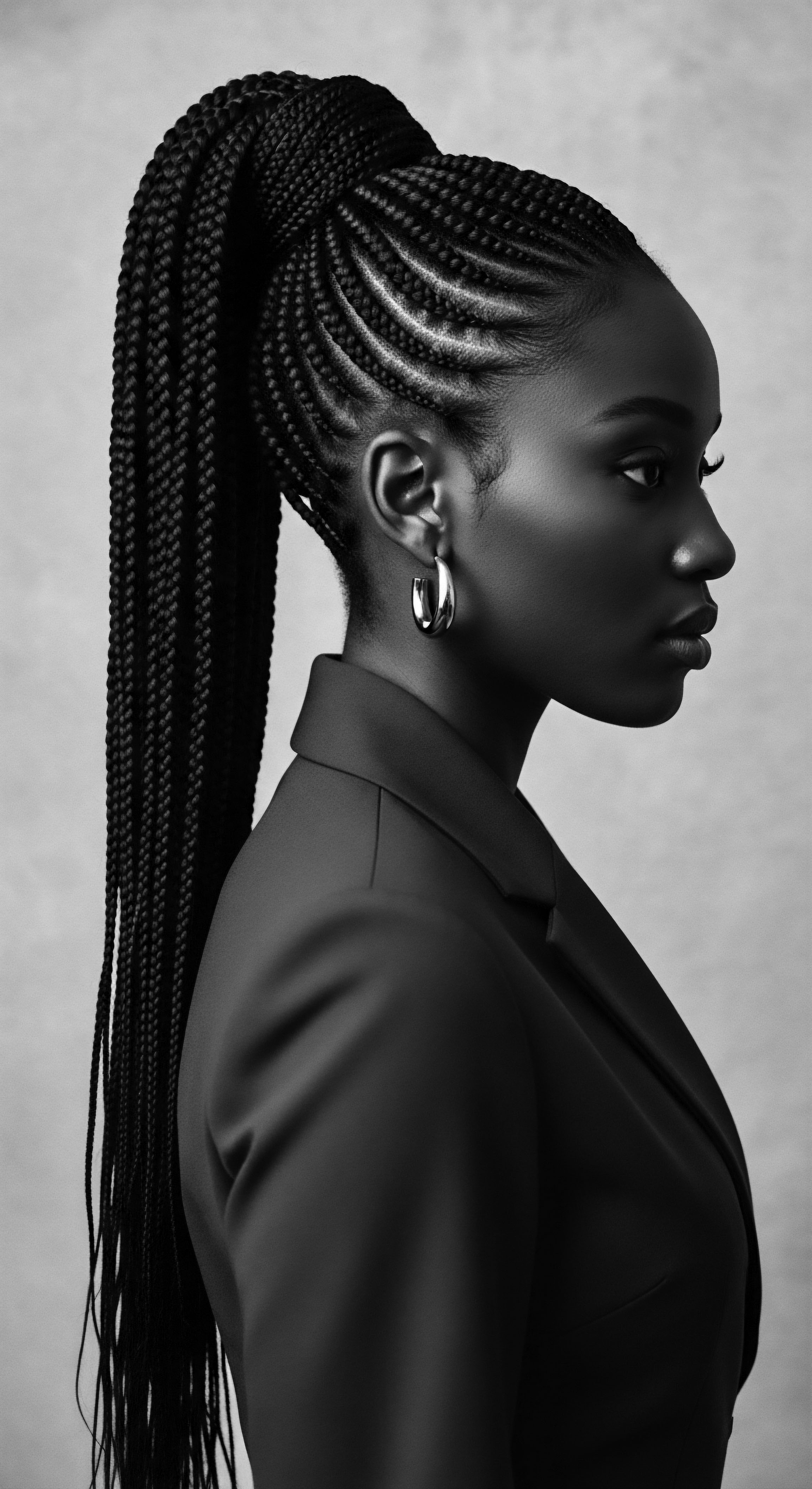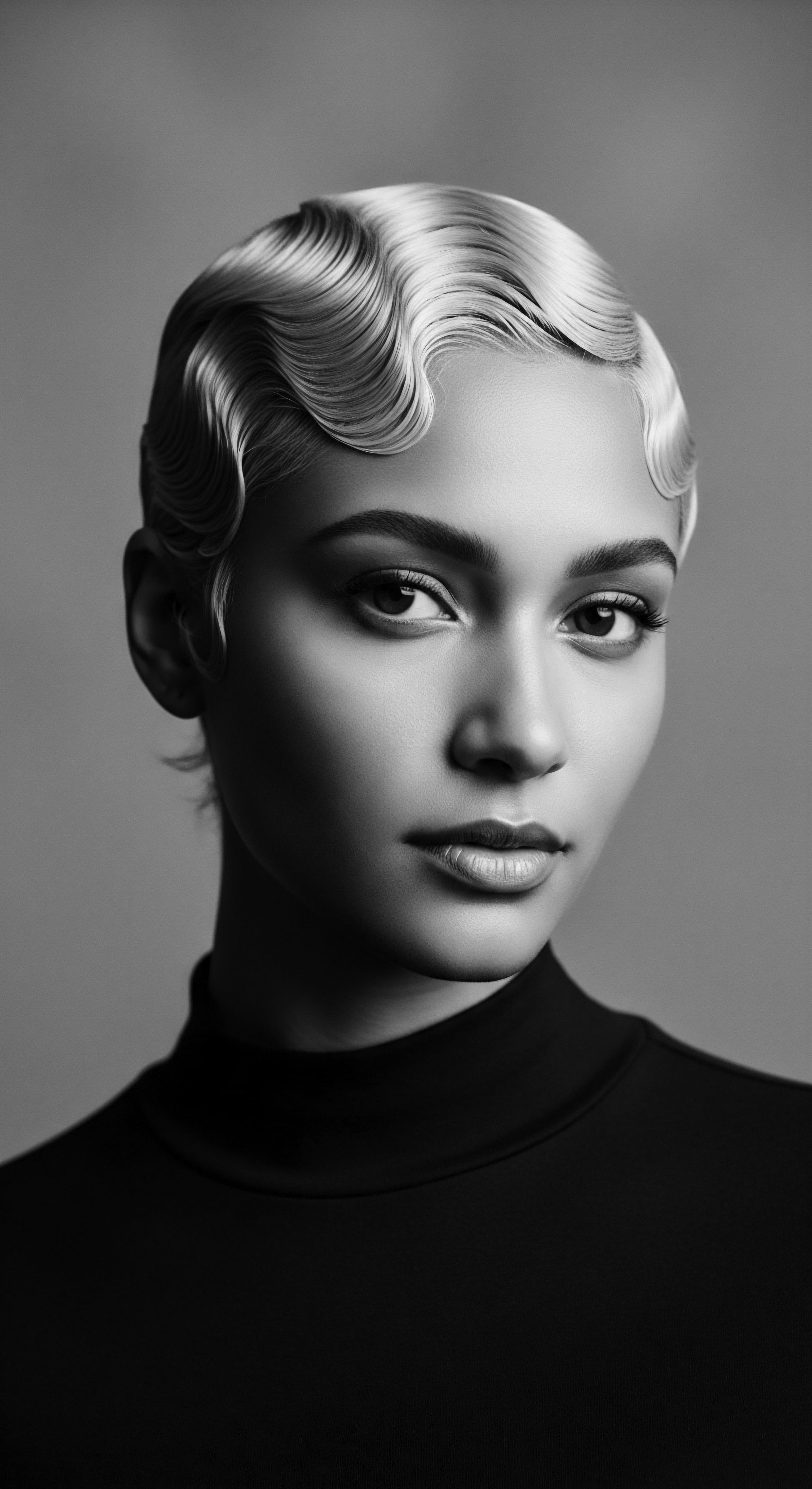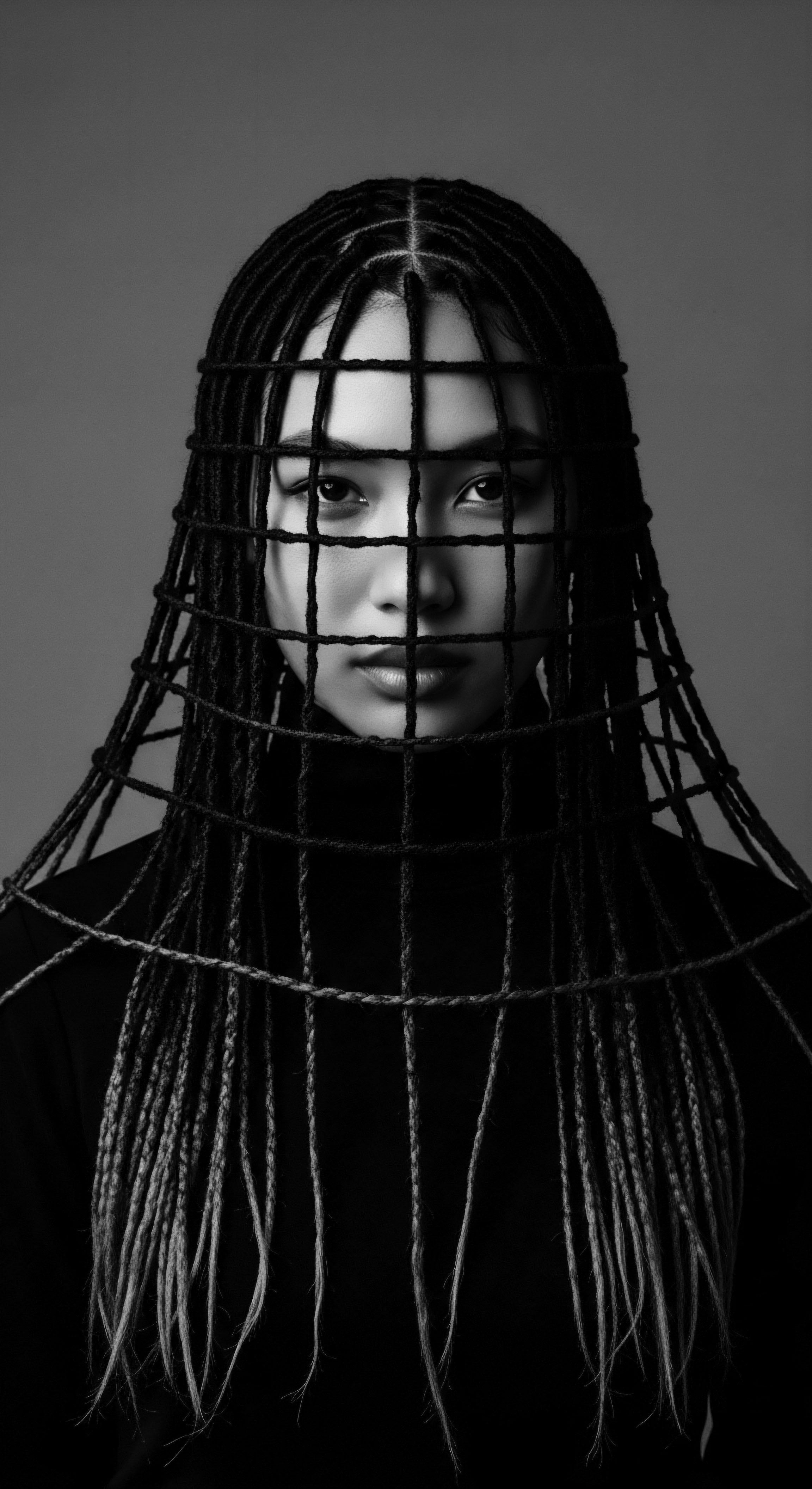
Roots
Consider for a moment the very helix of textured hair, each strand a coiled lineage, a testament to ancient suns and ancestral winds. It is a biological marvel, yes, but more profoundly, it is a living archive. Within its very structure lies the whisper of generations, the echo of practices honed over millennia. When we speak of heat styling within this rich heritage, we approach not a mere technique, but a ceremonial engagement with a profound history, a journey through the very fabric of identity.
The fibers that grow from the scalp of those with textured hair possess a distinct morphology. Unlike straight strands, which descend in a cylindrical column, textured hair coils and spirals, creating various patterns. This architectural difference stems from the follicle’s shape—an oval or elliptical opening, dictating the hair shaft’s trajectory. The tighter the oval, the more pronounced the coil.
This inherent geometry affects how moisture is distributed along the strand and how it interacts with external elements. Before the advent of modern tools or even the hot comb, ancestral communities understood this intrinsic nature of their hair. They recognized its thirst, its tendency to resist certain manipulations, and its glorious capacity for volume and form.
Each textured strand holds a coiled lineage, a biological marvel interwoven with the historical wisdom of ancestral care and the journey of identity.
Hair, in numerous ancient African societies, held a place beyond mere adornment; it was a deeply symbolic communicator. Hairdressing practices were a visual language, capable of conveying an individual’s Ethnicity, Social Status, Marital Standing, or even their age and spiritual connections. One might observe intricate patterns, perhaps signifying membership in a particular clan or commemorating a significant life event like marriage or childbirth. These elaborate styles, often requiring hours of dedicated communal effort, were not simply about aesthetics; they were about affirming one’s place within the collective, a public declaration of one’s inherited and lived story.

What Does Hair Anatomy Tell Us About Ancestral Practices?
The very anatomy of textured hair, with its natural bends and turns, posed unique challenges and opportunities for early styling. Its innate dryness, a consequence of the cuticle layers not lying as flat as straighter hair, meant that moisture retention was a constant pursuit. Ancient cultures, long before scientific laboratories could dissect keratin chains, intuitively understood this. They developed extensive systems of care using abundant natural resources.
Think of the lavish application of plant-based oils and butters, often infused with indigenous herbs, designed to lubricify and protect the hair. These were not just beauty rituals; they were acts of preservation, safeguarding the hair from environmental rigors and maintaining its pliable strength for intricate sculpting.
For instance, in some West African traditions, specific oils like Shea Butter or Palm Oil were not just rubbed onto the hair; they were warmed gently over embers before application, perhaps through a vessel carved from wood or clay. This subtle application of warmth would have facilitated deeper penetration of the emollients, making the hair more supple for braiding or twisting. While not “heat styling” in the sense of altering texture, this practice reveals an early understanding of thermal influence on hair fibers. Such methods exemplify an ancestral science, passed down through generations, rooted in observation and deep connection to the environment.
The nomenclature surrounding textured hair has itself evolved, reflecting historical shifts and societal perspectives. Terms like “kinky” or “woolly,” often used disparagingly in colonial contexts, speak to a history of devaluing natural African hair. In contrast, traditional African societies possessed a nuanced vocabulary for describing the spectrum of hair textures and the multitude of styles they enabled.
These classifications, often tied to tribal identity or spiritual meaning, underscore a profound respect for hair in its diverse forms. Understanding these linguistic shifts helps us grasp the cultural battles fought over hair texture.

Ritual
The journey of textured hair through history is marked by a profound interaction with heat. This interaction transcends mere aesthetics, becoming deeply embedded in the social, economic, and identity narratives of Black and mixed-race communities. While natural styling methods—braids, twists, and bantu knots—have ancient, revered origins, the advent of heat styling introduced a new dimension, one that carried both promise and peril.
Consider the hot comb. Its story is not simple; it is layered with complexity and contradiction. While a French hairdresser, Marcel Grateau, introduced heated irons for hair in the late 19th century, its popularization within the African American community took on a distinctive cultural significance. Pioneers like Annie Malone and her student, Madam C.J.
Walker, did not invent the hot comb, but they transformed its reach. They built empires around hair care systems that included the hot comb, making it accessible to Black women who sought to alter their hair’s texture. Walker’s innovative approach extended beyond simply selling a tool; her system focused on scalp health and hair growth, aiming to provide comprehensive care. The hot comb allowed for a temporary straightening that was less damaging than some harsh chemical alternatives of the era.
The hot comb, a symbol of complex heritage, became both a tool for assimilation and an instrument of economic self-sufficiency for Black women.
The adoption of heat styling, particularly hot combing, was a multifaceted phenomenon. For some, it represented a pathway to assimilation, a means of aligning with pervasive Eurocentric beauty standards that often equated straight hair with respectability and professionalism. In the early 1900s, this conformity could facilitate access to jobs and social mobility, creating a powerful incentive for women navigating a society rife with racial prejudice.
Hair that was “straightened” was often deemed “good hair,” while natural, coiled textures were stigmatized as “bad hair” or “unkempt” (Riley, 2022). This painful dichotomy was a direct consequence of a racialized beauty hierarchy, forcing difficult choices upon individuals.
Yet, the hot comb was also an instrument of economic self-determination. The networks of Black women who became beauty culturists, trained by institutions like Malone’s Poro College or Walker’s Lelia College, created independent economic opportunities. These women travelled, taught, and sold products, building wealth and community in a segregated society.
Hair salons became vital social hubs, places where women gathered not only for styling but for camaraderie, sharing stories, and forging connections. The ritual of the weekly “press and curl” was often a cherished moment of self-care and communal bonding, despite the physical discomfort it sometimes entailed, such as the smell of burning grease or the risk of scalp burns (Sanders & Williams, 2020).

How Did Early Heat Styling Tools Shape Identity?
The impact of the hot comb on identity was profound and, at times, contradictory. It provided a degree of stylistic versatility, allowing individuals to present themselves differently in various social settings. However, it also fueled internal debates within the Black community about authenticity and self-acceptance.
The pressure to conform to mainstream beauty ideals was immense, leading many to feel their natural hair was somehow inadequate. This historical tension highlights the enduring struggle for Black individuals to define beauty on their own terms, free from external impositions.
Consider the phenomenon of “the comb test,” a historical barrier to advancement. Organizations in the U.S. might hang a fine-tooth comb outside their doors, signaling that if one’s hair could not be easily combed through, entry was denied (HALO Collective, n.d.). Similarly, during Apartheid, the “Pencil Test” in South Africa determined racial classification based on whether a pencil could be held in one’s hair while shaking their head; a dropped pencil meant classification as white (HALO Collective, n.d.).
These insidious tests underscore the pervasive nature of hair discrimination and the extreme lengths to which individuals were compelled to alter their hair for survival and acceptance. Heat styling, then, was not merely a choice; it was often a strategic adaptation within a hostile environment.
| Aspect Primary Goal |
| Ancestral Care (Pre-Colonial) Hair nourishment, communal bonding, identity expression. |
| Early Heat Styling (Post-Slavery) Temporary texture alteration, social conformity, economic opportunity. |
| Aspect Tools/Methods |
| Ancestral Care (Pre-Colonial) Wooden combs, bone picks, warming natural oils, intricate braiding. |
| Early Heat Styling (Post-Slavery) Heated iron combs, hot combs, greases, and pressing oils. |
| Aspect Cultural Context |
| Ancestral Care (Pre-Colonial) Deep spiritual significance, tribal markers, community rituals. |
| Early Heat Styling (Post-Slavery) Navigating Eurocentric beauty standards, seeking social acceptance. |
| Aspect Potential Outcomes |
| Ancestral Care (Pre-Colonial) Healthy hair, strengthened community ties, cultural continuity. |
| Early Heat Styling (Post-Slavery) Temporary straightened hair, scalp burns, internal identity conflict. |
| Aspect The shift towards heat styling reflects a forced adaptation and complex negotiation of identity within diasporic communities. |

Relay
The story of heat styling within textured hair heritage extends far beyond the early 20th century. Its implications resonate across decades, influencing self-perception, societal expectations, and collective movements for liberation. The historical weight of the hot comb, and later chemical relaxers, cannot be understated. These tools and techniques were woven into the very fabric of Black life, shaping daily routines and public presentations, often dictating access to opportunity in a world still bound by narrow beauty ideals.
The pervasive notion of “good hair” versus “bad hair,” directly linked to the widespread adoption of straightening methods, exerted immense psychological pressure. This internalised hierarchy, a remnant of enslavement and its associated dehumanization, meant that natural hair, in its unadulterated state, was frequently seen as a barrier to success and even respectability. Women felt compelled to straighten their hair for job interviews, school pictures, or simply to avoid social ostracization. This phenomenon highlights a stark reality ❉ heat styling, for many, was not a mere choice but a necessary act of survival in racially discriminatory environments (Johnson & Bankhead, 2014; Noma Sana, 2024).

How Did Social Movements Reframe Heat Styling?
The mid-20th century, however, witnessed a powerful shift. The Civil Rights Movement and the Black Power Movement of the 1960s and 1970s sparked a profound reclamation of Black identity, challenging Eurocentric beauty standards with assertive self-love. The Afro emerged as a potent symbol of defiance and cultural pride.
This era saw a deliberate turning away from heat styling and chemical alterations, embracing the natural coil as a political statement. Icons like Angela Davis and the musical group Sweet Honey in the Rock, with their magnificent Afros, helped cement this stylistic revolution, signaling a collective desire to define beauty on their own terms.
Yet, the relationship with heat styling never truly vanished. After the initial surge of the natural hair movement, chemically straightened hair and thermal tools regained popularity in the 1980s and beyond. The “press and curl” remained a staple, evolving with new technologies like flat irons and blow dryers. For some, it represented a preference, a choice for versatility.
For others, it remained a subtle, sometimes unconscious, compromise with persistent societal pressures. The Dominican blowout, for example, gained prominence as a non-chemical temporary straightening method, offering an alternative to relaxers while still achieving a smooth finish (Wikipedia, n.d.). This ongoing tension underscores the enduring legacy of beauty standards and the complex individual and collective negotiations within the heritage of textured hair.
The contemporary landscape of textured hair care reflects this layered history. While the natural hair movement continues its vigorous growth, celebrating every curl and kink, heat styling remains a part of many routines. The difference today often lies in awareness and intent.
There is a greater emphasis on Heat Protectants, lower temperatures, and techniques that minimize damage, acknowledging the hair’s delicate structure while still allowing for stylistic exploration. This informed approach seeks to harmonize modern conveniences with the intrinsic health of the hair, drawing lessons from both ancestral wisdom and scientific understanding.
The discussion around heat styling is, at its heart, a discussion about agency and self-definition. It speaks to the resilience of communities who have consistently adapted, innovated, and resisted in the face of imposed ideals. Understanding this historical arc is essential for appreciating the choices individuals make about their hair today.
It is a dialogue between the echoes of the past and the aspirations for an unbound future, where every strand can express its unique truth without external judgment. The continuing evolution of tools and techniques for textured hair, from steam to ceramic, reflects a community perpetually seeking healthier, more affirming ways to sculpt and adorn their crowns.
- Tools ❉ Early hot combs were heated on stoves, requiring precision and posing risks of burns (Sanders & Williams, 2020).
- Societal Pressure ❉ Straight hair was often linked to “good grooming” and facilitated social acceptance and employment opportunities (Banks, 2000; Craig, 2002; Oxford Research Encyclopedia of American History, 2017).
- Economic Empowerment ❉ Figures like Madam C.J. Walker built successful businesses, offering products and training that provided economic independence for Black women (Malone, 2022).

Reflection
To truly grasp the soul of a strand, we must sit with its story, not merely observe it. The historical significance of heat styling within textured hair heritage is a narrative rich with resilience, adaptation, and an enduring quest for self-expression. It is a story told not just through tools and techniques, but through the hands that wielded them, the scalps that felt their warmth, and the lives that were shaped by the styles created. From the whispers of ancestral practices that subtly warmed natural emollients to the transformative sizzle of the hot comb, heat has played a complex, undeniable role.
This journey reminds us that textured hair is far more than a collection of fibers; it is a profound testament to memory, a living chronicle of joy and struggle, conformity and rebellion. Each coiled pattern carries the weight of history—the indignities of forced assimilation, the ingenuity of entrepreneurial spirit, and the powerful embrace of natural beauty. The choices made about hair, particularly those involving heat, were rarely simple acts of vanity; they were often responses to profound societal pressures, acts of defiance, or expressions of personal identity in a world that sought to dictate norms.
As we look upon the vibrant spectrum of textured hairstyles today, we see the cumulative wisdom of generations. We witness the blending of ancient reverence for hair with modern understanding of its care. The dialogue around heat styling continues, informed by a deeper appreciation for hair health and a cultural awakening that cherishes every natural form. The heritage of textured hair, with all its nuanced experiences with heat, stands as a luminous reminder that true beauty blossoms when rooted in authenticity, honouring the lineage held within each magnificent strand.

References
- Banks, Ingrid. 2000. Hair Matters ❉ Beauty, Power, and Black Women’s Consciousness. New York University Press.
- Craig, Maxine Leeds. 2002. Ain’t I a Beauty Queen? ❉ Black Women, Beauty, and the Politics of Race. Oxford University Press.
- HALO Collective. n.d. End Hair Discrimination.
- Johnson, T. and Bankhead, T. 2014. Hair It Is ❉ Examining the Experiences of Black Women with Natural Hair. Open Journal of Social Sciences, 2.
- Malone, Annie. 2022. It’s More Than “Just” Hair ❉ Revitalization of Black Identity. Folklife Magazine.
- Noma Sana. 2024. The History of Straightening Afro Hair ❉ Culture, Trends & Identity.
- Oxford Research Encyclopedia of American History. 2017. Black Women and Beauty Culture in 20th-Century America.
- Riley, Kerry. 2022. It’s More Than “Just” Hair ❉ Revitalization of Black Identity. Folklife Magazine.
- Sanders, Shanita and Williams, Syerra. 2020. Stories from the HistoryMakers ❉ HOT Comb. Forsyth County, North Carolina.
- Wikipedia. n.d. Hair straightening.
